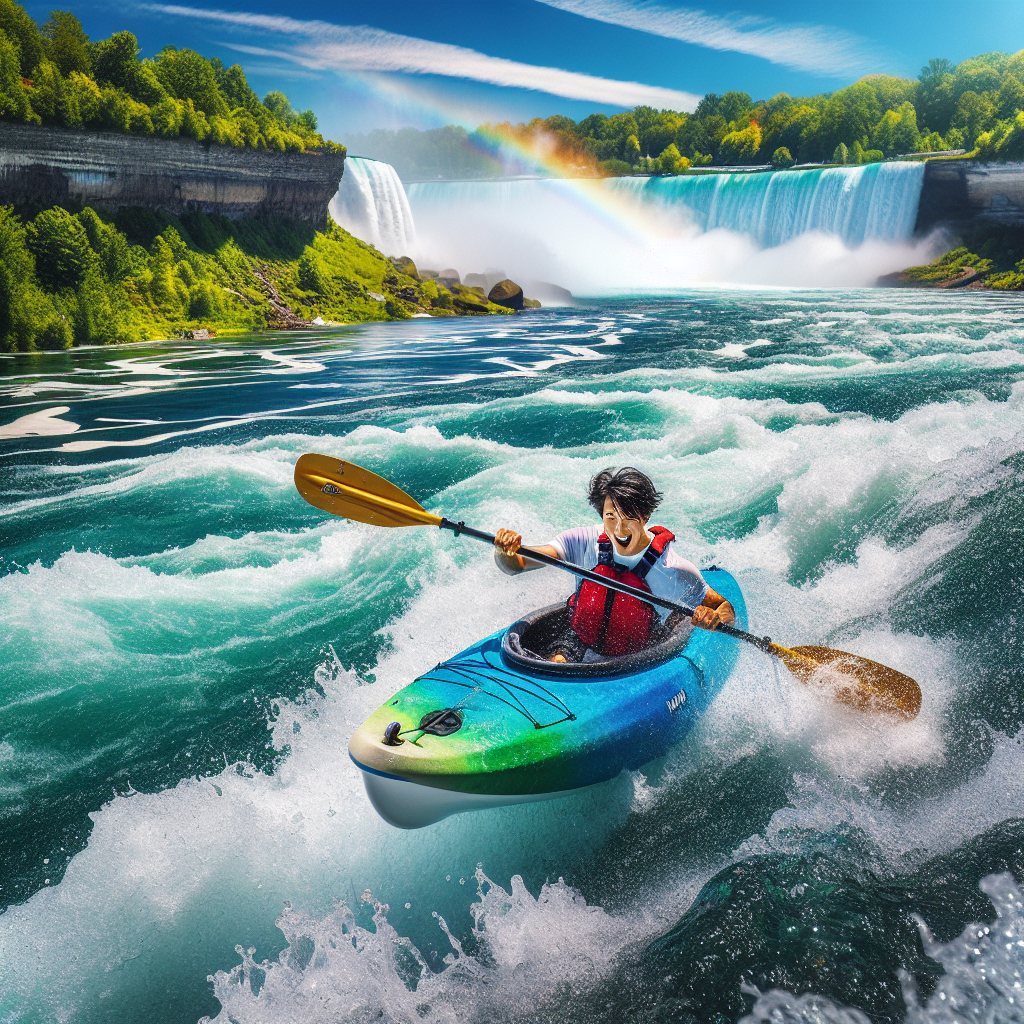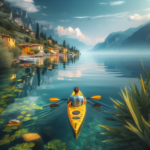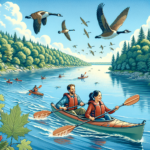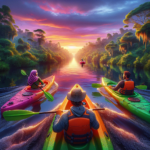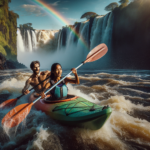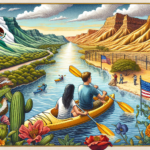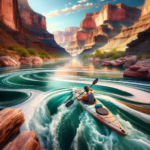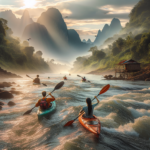Kayaking in Niagara River, USA/Canada
Introduction to Kayaking
Kayaking is a popular outdoor activity that offers a unique blend of adventure, exercise, and a close connection with nature. Whether you’re paddling through serene lakes, navigating winding rivers, or tackling challenging rapids, kayaking provides an exhilarating experience that appeals to both beginners and seasoned enthusiasts. The sport has grown in popularity over the years, thanks to its accessibility and the sheer joy it brings to those who partake in it.
In this article, we will spotlight the unique features of kayaking in the Niagara River, which straddles the border between the USA and Canada. This destination is renowned for its stunning natural beauty, diverse wildlife, and thrilling water conditions, making it a fantastic spot for kayaking enthusiasts. We’ll explore what makes the Niagara River a must-visit location for anyone looking to experience the best of what kayaking has to offer.
Kayaking in the Niagara River offers a unique experience that combines the thrill of navigating powerful currents with the opportunity to explore one of North America’s most iconic natural landmarks. The river’s diverse sections cater to all skill levels, from calm waters ideal for beginners to challenging rapids that will test even the most experienced kayakers. Additionally, the river’s rich history and cultural significance add an extra layer of intrigue to your kayaking adventure.
Whether you’re seeking a peaceful paddle through scenic landscapes or an adrenaline-pumping ride through turbulent waters, the Niagara River has something for everyone. Join us as we delve into the details of kayaking in this remarkable location, from the best spots to paddle to essential safety tips and everything in between.
Overview of Kayaking in Niagara River, USA/Canada
The Niagara River is a natural wonder that flows from Lake Erie to Lake Ontario, forming part of the border between the United States and Canada. This 36-mile-long river is divided into two main sections: the upper river, which is relatively calm and ideal for leisurely paddling, and the lower river, which features more challenging rapids and is perfect for thrill-seekers. The river’s geography is characterized by its stunning waterfalls, lush greenery, and diverse wildlife, making it a picturesque setting for kayaking.
The climate in the Niagara River region varies throughout the year, with warm summers and cold winters. The best time to visit for kayaking is typically from late spring to early fall when the weather is mild, and the water conditions are most favorable. During these months, kayakers can enjoy pleasant temperatures and relatively calm waters, making for an enjoyable and safe experience.
Accessing the Niagara River for kayaking is relatively straightforward, with several launch points and access areas available on both the American and Canadian sides. Popular launch sites include the Niagara Glen Nature Centre in Ontario and the Lewiston Landing in New York. These locations offer convenient parking, restrooms, and other amenities to ensure a smooth start to your kayaking adventure.
The Niagara River has a rich history and cultural significance, particularly for the indigenous peoples who have lived in the region for thousands of years. The river has also played a crucial role in the development of the surrounding areas, serving as a vital transportation route and a source of hydroelectric power. Today, the river continues to be a popular destination for outdoor enthusiasts, including kayakers who are drawn to its natural beauty and exciting water conditions.
Kayaking Conditions in Niagara River, USA/Canada
The Niagara River offers a diverse range of water conditions that cater to kayakers of all skill levels. The upper river, which stretches from Lake Erie to the brink of Niagara Falls, features relatively calm waters that are perfect for beginners and those looking for a more relaxed paddling experience. This section of the river is characterized by its wide, slow-moving waters and scenic surroundings, making it an ideal spot for leisurely kayaking.
In contrast, the lower river, which flows from the base of Niagara Falls to Lake Ontario, presents more challenging conditions that are best suited for experienced kayakers. This section of the river is known for its powerful currents, turbulent rapids, and narrow gorges, providing an adrenaline-pumping experience for those who are up to the challenge. The lower river’s fast-moving waters and dramatic landscapes make it a thrilling destination for adventurous kayakers.
The weather conditions in the Niagara River region can vary significantly throughout the year, impacting the overall kayaking experience. During the summer months, temperatures are typically warm, and the water levels are relatively stable, making it an ideal time for kayaking. In contrast, the winter months can bring cold temperatures, ice, and snow, making kayaking more challenging and potentially hazardous. It’s essential to check the weather forecast and water conditions before embarking on a kayaking trip to ensure a safe and enjoyable experience.
Tides and water currents are also important factors to consider when kayaking in the Niagara River. The river’s flow is influenced by the outflow from Lake Erie and the inflow to Lake Ontario, resulting in varying water levels and currents throughout the year. Additionally, the river’s proximity to Niagara Falls means that water conditions can change rapidly, particularly in the lower river. Kayakers should be aware of these factors and plan their trips accordingly to ensure a safe and enjoyable experience.
Top Spots for Kayaking in Niagara River, USA/Canada
One of the top spots for kayaking in the Niagara River is the upper river section near Grand Island. This area offers calm waters and beautiful scenery, making it an ideal location for beginners and those looking for a relaxing paddle. The wide, slow-moving waters provide ample opportunities to explore the river’s natural beauty, including lush forests, picturesque islands, and diverse wildlife. The best time to kayak in this area is during the early morning or late afternoon when the water is calm, and the scenery is at its most stunning.
Another popular spot for kayaking is the Niagara Glen Nature Centre in Ontario. This location offers access to the lower river’s more challenging rapids and narrow gorges, providing an exhilarating experience for experienced kayakers. The dramatic landscapes and powerful currents make this area a must-visit for thrill-seekers looking to test their skills. The best time to kayak in this area is during the summer months when the water levels are stable, and the weather is warm.
For those looking to combine kayaking with a bit of history, the Lewiston Landing in New York is an excellent choice. This area offers access to the lower river and features several historical landmarks, including the Lewiston-Queenston Bridge and the remnants of old forts. The combination of exciting water conditions and historical significance makes this spot a unique and memorable kayaking destination. The best time to visit is during the late spring or early fall when the weather is mild, and the water conditions are favorable.
Lastly, the area around Navy Island, located near the mouth of the Niagara River, is another top spot for kayaking. This area offers a mix of calm waters and moderate currents, making it suitable for kayakers of all skill levels. The island itself is rich in history and natural beauty, providing plenty of opportunities for exploration and adventure. The best time to kayak in this area is during the summer months when the weather is warm, and the water levels are stable.
Safety and Regulations
Safety is paramount when kayaking in the Niagara River, given the varying water conditions and potential hazards. Local regulations require all kayakers to wear a personal flotation device (PFD) at all times while on the water. Additionally, it’s essential to carry a whistle or other sound-producing device to signal for help in case of an emergency. Kayakers should also be aware of the river’s specific rules and guidelines, such as designated launch points and restricted areas, to ensure a safe and enjoyable experience.
When it comes to safety gear, it’s crucial to be well-prepared before heading out on the water. In addition to a PFD, kayakers should carry a first aid kit, a waterproof map of the area, and a fully charged mobile phone or marine radio for communication. It’s also a good idea to bring along extra clothing, food, and water, especially if you plan to be on the river for an extended period. Being well-prepared can make all the difference in ensuring a safe and enjoyable kayaking experience.
Handling emergency situations while kayaking in the Niagara River requires knowledge and preparation. If you find yourself in a dangerous situation, such as capsizing or getting caught in strong currents, it’s essential to stay calm and follow proper safety procedures. If you capsize, try to stay with your kayak and use it as a flotation device while signaling for help. If you’re caught in strong currents, paddle at an angle to the current to gradually make your way to calmer waters. Knowing how to handle these situations can help prevent accidents and ensure your safety on the water.
Local authorities and organizations also offer resources and support for kayakers in the Niagara River region. Many areas have designated safety patrols and rescue teams that monitor the river and provide assistance in case of emergencies. Additionally, local kayaking clubs and organizations often offer safety courses and training sessions to help kayakers develop their skills and knowledge. Taking advantage of these resources can enhance your safety and enjoyment while kayaking in the Niagara River.
Amenities and Accommodations
The Niagara River region offers a variety of amenities to support your kayaking adventure. Several rental facilities provide kayaks, paddles, and safety gear, making it easy for visitors to get out on the water without needing to bring their own equipment. Additionally, guided tours are available for those who prefer a more structured experience or want to learn more about the area’s history and natural features. These tours are led by experienced guides who can provide valuable insights and ensure a safe and enjoyable trip.
When it comes to accommodations, the Niagara River region has something for everyone. For those who enjoy camping, there are several campgrounds located near the river, offering a range of amenities from basic tent sites to fully-equipped RV parks. These campgrounds provide a convenient and affordable option for visitors who want to immerse themselves in nature and enjoy the great outdoors.
If you prefer more comfortable accommodations, there are numerous hotels and lodges located in the nearby towns and cities. These establishments offer a range of options, from budget-friendly motels to luxurious resorts, ensuring that you can find a place to stay that suits your needs and preferences. Many of these accommodations also offer additional amenities such as restaurants, pools, and fitness centers, providing a comfortable and convenient base for your kayaking adventure.
In addition to kayaking, the Niagara River region offers a variety of other recreational activities for visitors to enjoy. Hiking and biking trails are abundant in the area, providing opportunities to explore the region’s natural beauty on land. Fishing is also a popular activity, with the river offering excellent opportunities to catch a variety of fish species. For those interested in history and culture, there are several museums, historical sites, and cultural attractions to explore. With so much to see and do, the Niagara River region is an ideal destination for outdoor enthusiasts and adventure seekers.
Environmental Considerations
Preserving the natural habitats and wildlife of the Niagara River is essential for ensuring that future generations can enjoy this beautiful and unique environment. As kayakers, it’s important to practice eco-friendly habits to minimize our impact on the river and its surroundings. This includes avoiding littering, respecting wildlife, and staying on designated paths and launch points to prevent erosion and damage to natural habitats.
One of the key principles of eco-friendly kayaking is to leave no trace. This means packing out all trash and belongings, avoiding the use of single-use plastics, and being mindful of your impact on the environment. Additionally, it’s important to use biodegradable and environmentally-friendly products whenever possible, such as sunscreen and insect repellent, to minimize pollution and protect the river’s delicate ecosystems.
Supporting local conservation efforts is another way to contribute to the preservation of the Niagara River. Many organizations and initiatives are dedicated to protecting the river’s natural habitats and wildlife, and they rely on the support of visitors and the local community to continue their work. Consider donating to or volunteering with these organizations to help make a positive impact on the environment.
Finally, educating yourself and others about the importance of environmental conservation is crucial for fostering a culture of sustainability and respect for nature. Share your knowledge and experiences with fellow kayakers and encourage them to adopt eco-friendly practices. By working together, we can help ensure that the Niagara River remains a beautiful and thriving destination for kayaking and other outdoor activities for years to come.
Highlights
When comparing kayaking in the Niagara River to other popular kayaking destinations, several unique features stand out. One of the most notable aspects of the Niagara River is its diverse range of water conditions, which cater to kayakers of all skill levels. From the calm waters of the upper river to the challenging rapids of the lower river, there is something for everyone, making it an ideal destination for both beginners and experienced kayakers.
The river’s stunning natural beauty is another highlight that sets it apart from other kayaking locations. The Niagara River is home to a variety of picturesque landscapes, including lush forests, dramatic gorges, and iconic waterfalls. This diverse scenery provides a visually captivating backdrop for your kayaking adventure, making it a truly memorable experience.
In addition to its natural beauty, the Niagara River boasts a rich history and cultural significance that adds an extra layer of intrigue to your kayaking experience. The river has played a crucial role in the development of the surrounding areas and has been a vital transportation route for thousands of years. Exploring the river allows you to connect with this history and gain a deeper appreciation for the region’s cultural heritage.
Finally, the Niagara River’s unique biodiversity is another factor that sets it apart from other kayaking destinations. The river is home to a wide variety of plant and animal species, providing ample opportunities for wildlife observation and nature photography. From birds and fish to mammals and reptiles, the river’s diverse ecosystems offer a fascinating glimpse into the natural world, making your kayaking adventure even more rewarding.
FAQ Section
- What is the best season to go kayaking in the Niagara River? The best season for kayaking in the Niagara River is from late spring to early fall when the weather is mild, and the water conditions are most favorable.
- Are there beginner-friendly spots for kayaking in the Niagara River? Yes, the upper river section near Grand Island offers calm waters that are ideal for beginners.
- What should I bring for a kayaking trip in the Niagara River? Essential items include a personal flotation device (PFD), a whistle, a first aid kit, a waterproof map, extra clothing, food, water, and a fully charged mobile phone or marine radio.
- Are kayak rentals available in the Niagara River region? Yes, several rental facilities provide kayaks, paddles, and safety gear for visitors.
- How can I participate in local conservation efforts? You can support local conservation efforts by donating to or volunteering with organizations dedicated to protecting the river’s natural habitats and wildlife.
- Are guided kayaking tours available? Yes, guided tours are available for those who prefer a more structured experience or want to learn more about the area’s history and natural features.
- What safety measures are in place for kayaking in the Niagara River? Local regulations require all kayakers to wear a PFD at all times, and it’s essential to carry a whistle or other sound-producing device. Additionally, local authorities and organizations offer resources and support for kayakers.
Final Thoughts
Kayaking in the Niagara River is a premier destination for kayaking enthusiasts, offering a unique blend of natural beauty, diverse water conditions, and rich history. Whether you’re a beginner looking for a peaceful paddle or an experienced kayaker seeking an adrenaline-pumping adventure, the Niagara River has something for everyone. By respecting local guidelines and conservation efforts, we can help preserve this incredible environment for future generations to enjoy.
As you plan your kayaking adventure in the Niagara River, remember to prioritize safety and be well-prepared for the varying water conditions. Take advantage of the available amenities, guided tours, and local resources to enhance your experience and make the most of your time on the water. By following eco-friendly practices and supporting local conservation efforts, you can contribute to the preservation of this beautiful and unique destination.
In conclusion, kayaking in the Niagara River offers an unforgettable experience that combines the thrill of adventure with the serenity of nature. Whether you’re exploring the calm waters of the upper river or navigating the challenging rapids of the lower river, you’re sure to create lasting memories and develop a deeper appreciation for this remarkable location. So grab your paddle, embrace the adventure, and discover the beauty and excitement of kayaking in the Niagara River, USA/Canada.

